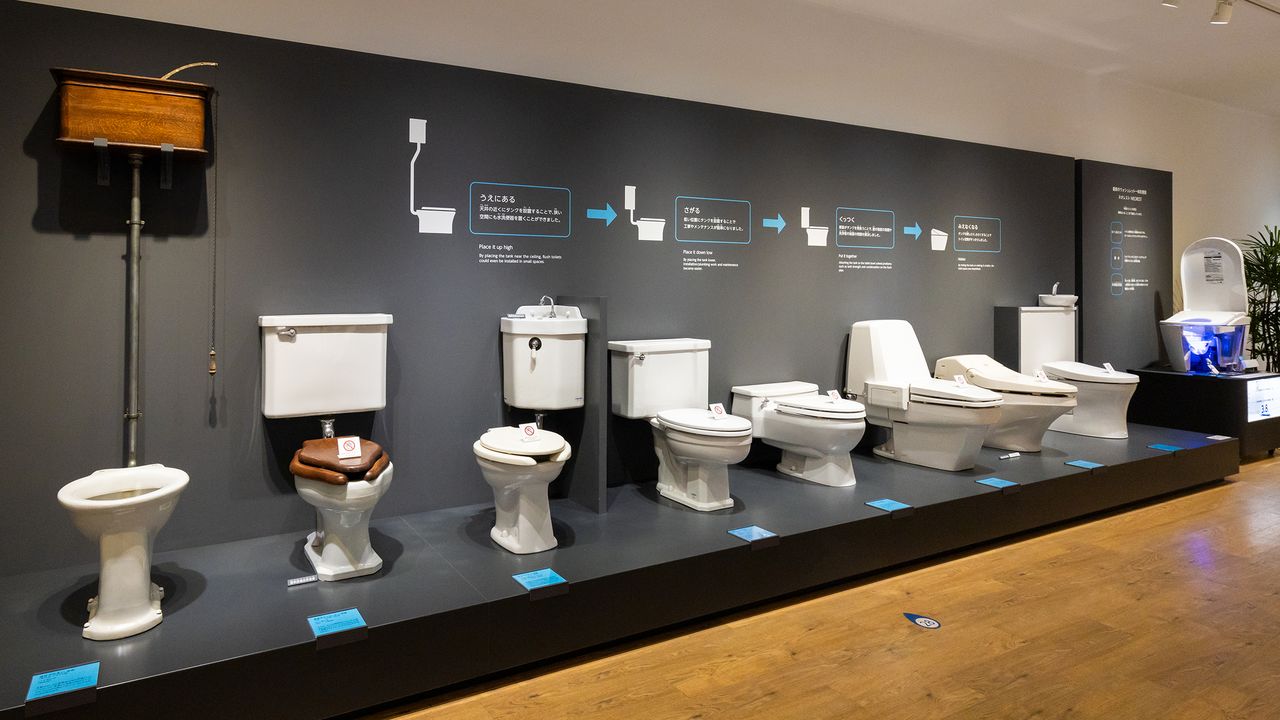
Learning about Japan’s Toilet Culture at the Toto Museum
Guideto Japan
Culture Travel- English
- 日本語
- 简体字
- 繁體字
- Français
- Español
- العربية
- Русский
From Throwback to the World’s Toilet Leader
The Japan National Tourism Organization calculated that the first half of 2024 saw almost 18 million visitors to the country, outpacing by a large margin the same period for 2019, which had a record-setting yearly total of 31 million. Surveys of the swelling numbers of tourists regarding things that stood out during their trips often received the answer, “The pleasant toilets.”
However, up until 2013—when Japan first passed 10 million overseas tourists—there had been many saying that toilet problems were a bottleneck preventing tourism growth. The largest issue was that public toilets were often washiki, or traditional squat-style, facilities. Visitors from the West are unaccustomed to the style, which can be hard on untrained legs and knees and prone to soiling, so many avoided using the toilets at sightseeing spots, parks, and train stations.
2013 was also the year that the 2020 Tokyo Olympics was announced, so the city began to replace toilets in public spaces with Western-style sit-down toilets. Most of those were also equipped with Japan’s vaunted warm-water bidet seats, taking Japan’s capital from a toilet throwback to a world leader in a single leap.
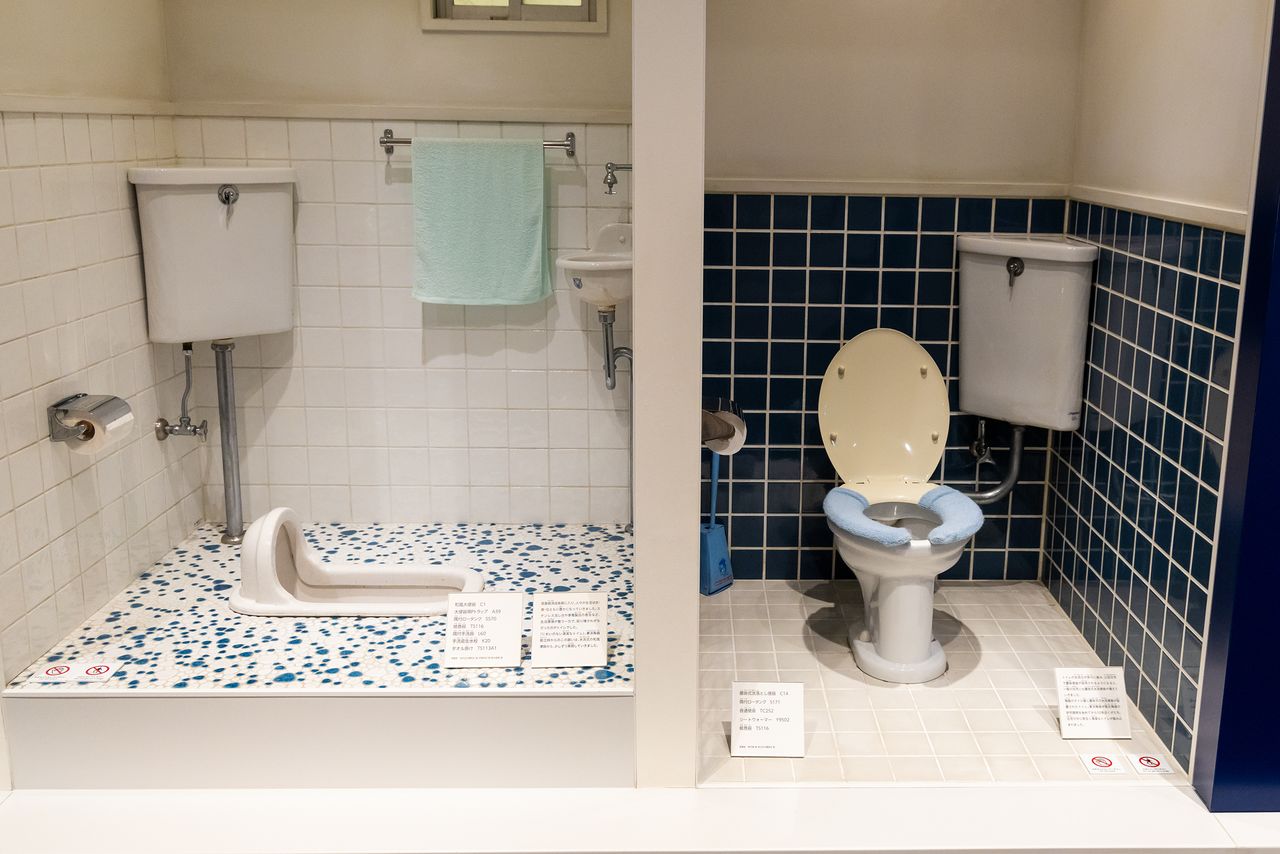
This display at the Toto Museum recreates the toilet spaces common during Japan’s early postwar period of rapid economic growth. Flushable washiki squat-style toilets (left) were by far the preferred style in private homes. (© Nippon.com)
The efforts of private enterprises in helping spread adoption of Western-style toilets and in raising their level of functionality in that time should not be forgotten. The household fixture company Toto, which developed the nation’s first domestic sit-down toilets, has continued to be a pioneer in Japan’s toilet industry, particularly by making its warm-water “Washlet” bidet seats a household name in Japan.
The Toto Museum, which stands on the grounds of the company headquarters in the city of Kitakyūshū, Fukuoka, has exhibits outlining not only the history and products of the company itself, but also the changes in Japan’s toilet culture. It is a fascinating addition to any tour of Kyūshū.

The Toto Museum has a porcelain-like white exterior. The dome at the left is patterned on a water droplet. (© Nippon.com)
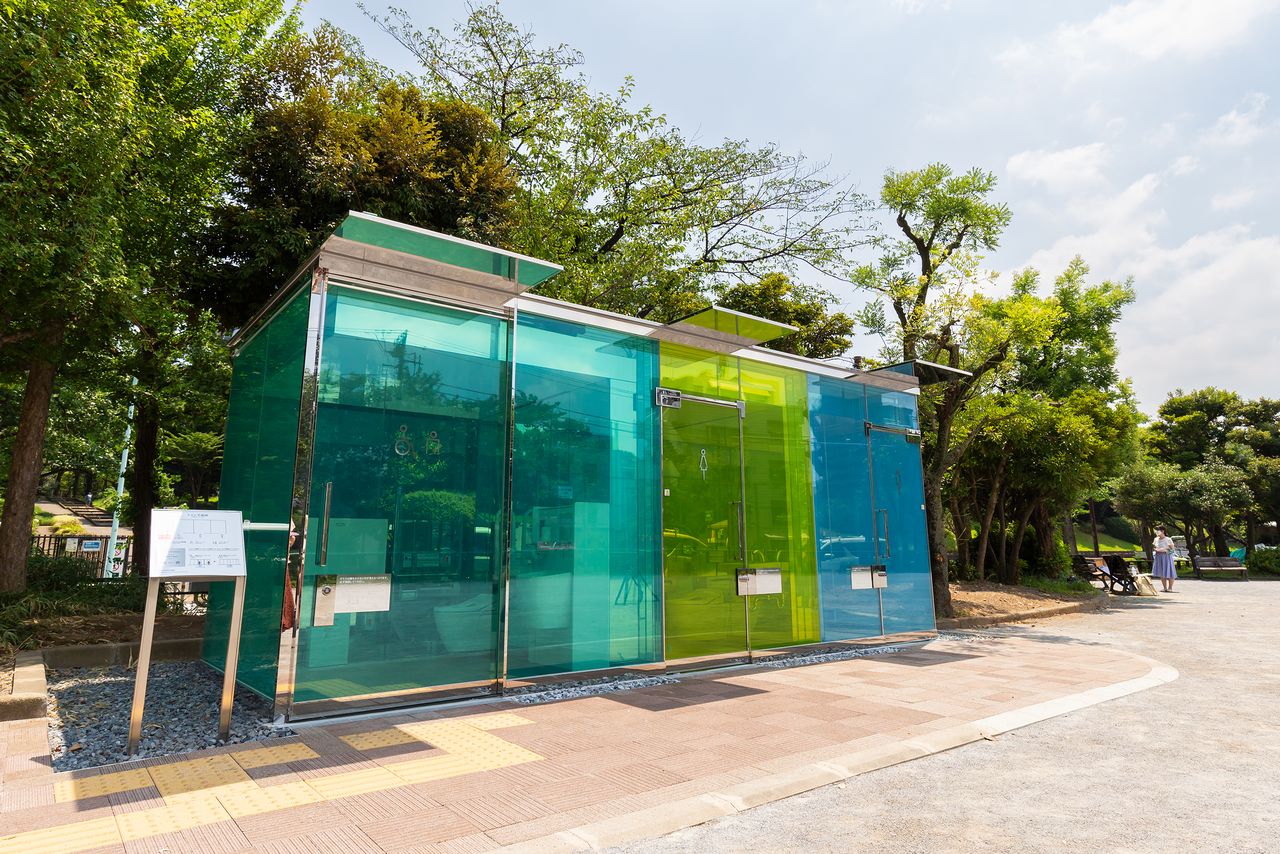
Toto also helped with equipment and installation for the Tokyo Toilet project in the city of Shibuya, which sought to revolutionize the idea of public toilets. Pictured is the Transparent Toilet, designed by Ban Shigeru. (© Nippon.com)
Origins as a Porcelain Maker
Inside Exhibition Room 1 stands a line of toilets, including Japan’s first domestic sit-down flushing toilet developed in 1914, and the first-generation Washlet sold in 1980.
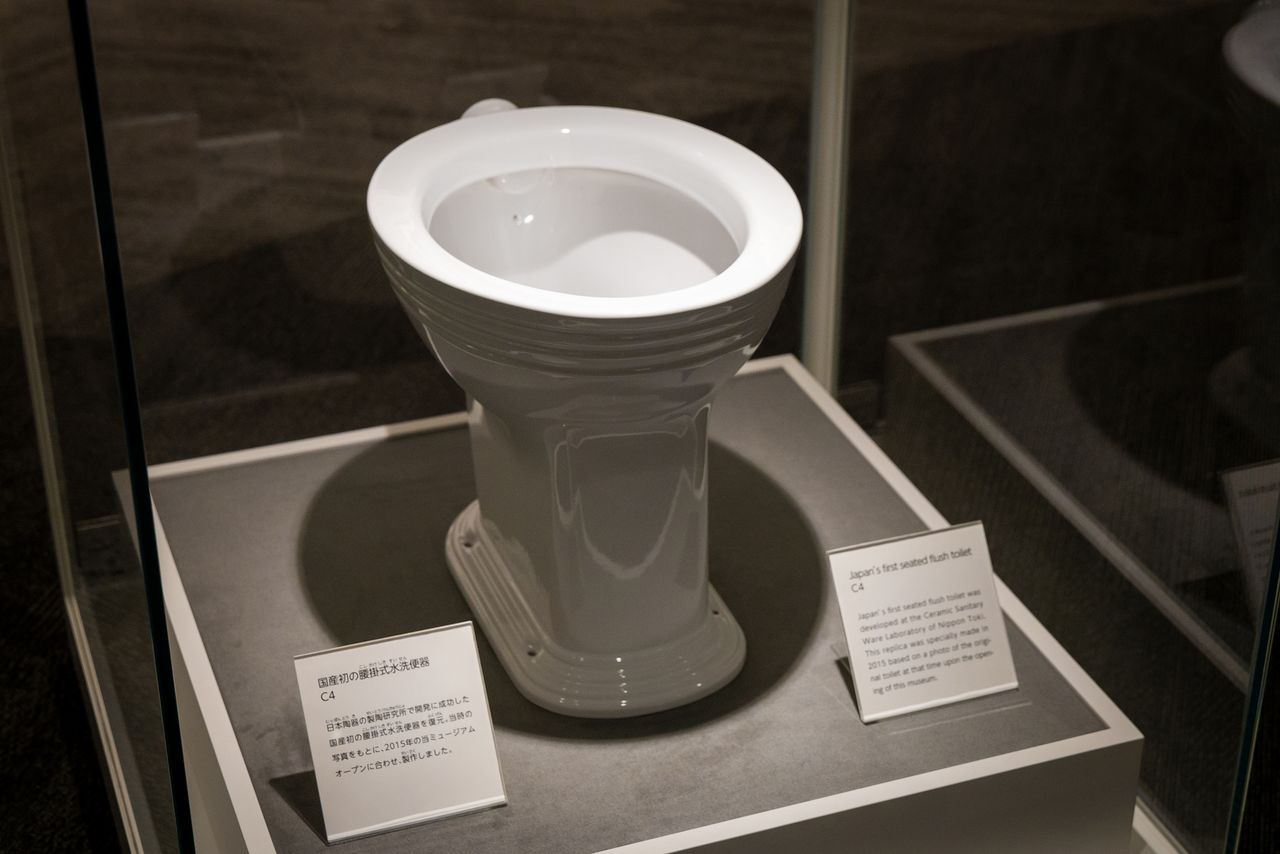
A re-creation of Japan’s first domestically produced sit-down toilet. (© Nippon.com)
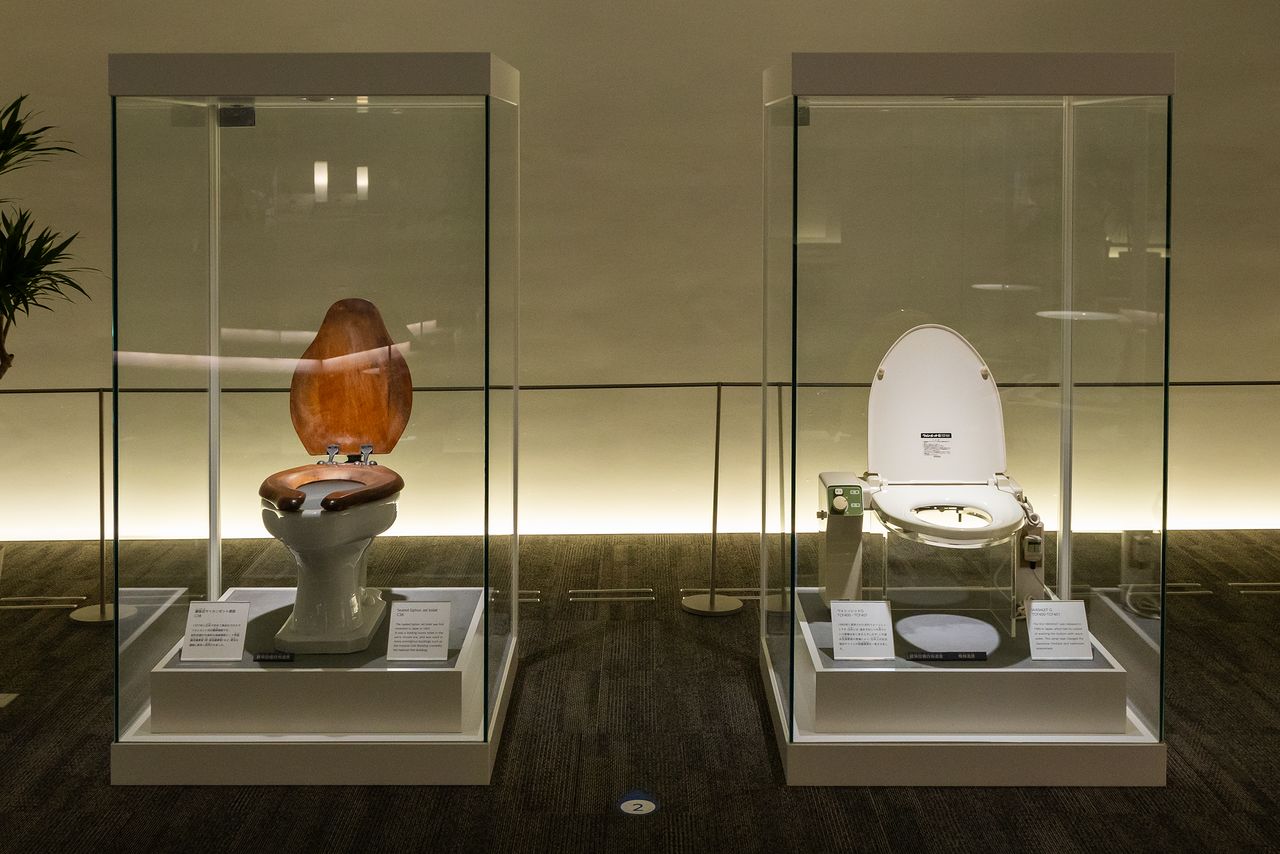
To the right is the first-generation Washlet. (© Nippon.com)
Toto started out as the sanitary ceramics division of Nippon Tōki Kaisha, now known as the tableware maker Noritake.
Morimura Ichizaemon, his brother-in-law Ōkura Magobē, and other family members founded Nippon Tōki in 1904 as Morimura Gumi trading company, in the village of Takaba, Aichi Prefecture. The first president of the company was Magobē’s son Kazuchika.
During a tour of Europe, the Ōkuras noticed how important sanitary porcelain items were for the pleasant, clean way of life there. However, the company’s executives opposed entering the business because they saw no demand, given that Japan still had no sewage system in place. The father and son persisted, though, and in 1912 they personally funded the construction of a porcelain production research lab on the company grounds. They started researching sanitary porcelain and just over two years later completed the first-ever Japanese-made sit-down flushing toilet.
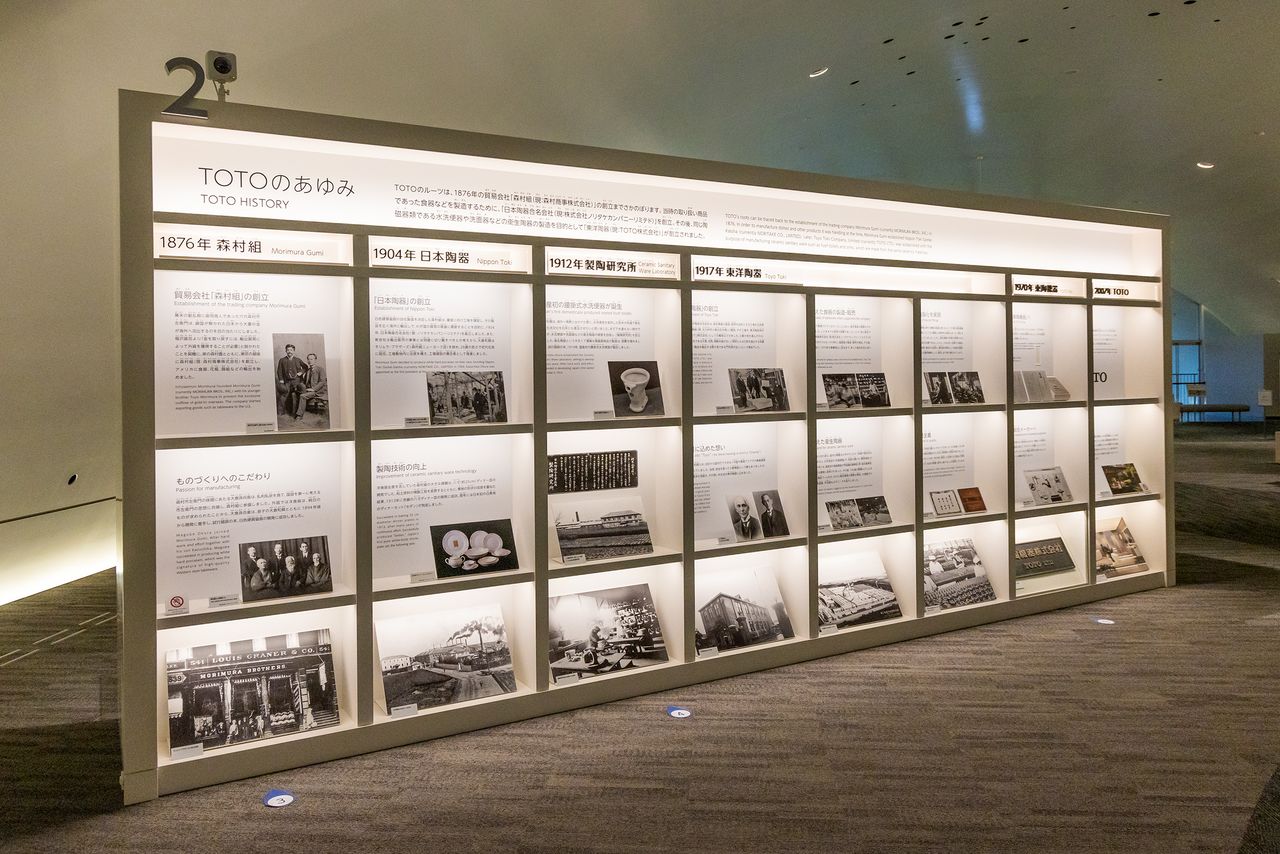
An outline of the company’s history. (© Nippon.com)

This display explains the evolution in toilets, from washiki toilets that needed water poured in to wash away waste to modern, sit-down flush toilets. (© Nippon.com)
In 1917, Ōkura Kazuchika went on to found sanitary porcelain maker Tōyō Tōki in Kokura, Fukuoka Prefecture. He chose that spot because it was near the Chikuhō coal fields for easy firing fuel, near sources of clay and porcelain stone at Amakusa, Kumamoto Prefecture, and Korea, and also convenient to the international trading port at Moji in Kitakyūshū, giving access to markets in China and Southeast Asia.
Exhibition Room 2 has a full lineup of Toto’s products through history, demonstrating the changes in Japan’s plumbing. Demand for sanitary porcelain in Japan grew after the Great Kantō Earthquake of 1923. As reconstruction efforts progressed, the development of taller buildings and more extensive sewerage led to a sudden spike in the need for porcelain toilets.
As it did, the issue of domestic production of metal faucet fixtures became more pressing. Porcelain sanitary equipment needs the proper metal hardware to be truly effective, and in 1946 Toto began producing its own faucets and attachments. From there, the company expanded into sinks, shower stalls, and fully fitted unit bathrooms, until it grew into a manufacturer for all things related to indoor plumbing.

At left are a sit-down toilet, urinal, and sink delivered to the Dai-Ichi Seimei Building, built in 1938, which became the center for the Supreme Commander for the Allied Powers after World War II. (© Nippon.com)
With the coming of the postwar economic boom, there was a growth in public housing that needed outfitting with flush toilets, baths, and kitchens. The 1964 Tokyo Olympics led to a boom in hotel building, which was when all-in-one “unit bathrooms” appeared. As high-rise buildings became more common, standardized “sanitary unit” restrooms were developed for office structures.
Tōyō Tōki shortened its commercial name to Toto in 1969, and in 1970 its official name became Tōtō Kiki. And finally, Toto’s sales of sit-down toilets outgrew washiki toilets in 1977.

The standardized toilet unit used in the Kasumigaseki building, which was Japan’s tallest high-rise building at its completion in 1968. (© Nippon.com)
From “Wiping” to “Washing”
The great revolution in Japan’s toilet culture came in 1980, with the release of the Washlet. Washlet is a registered trademark of the Toto corporation and is far and away the best known of all the Japan’s warm-water bidet toilet seats. Its great contribution to toilet culture is how it expanded the market for such devices to common homes and offices.
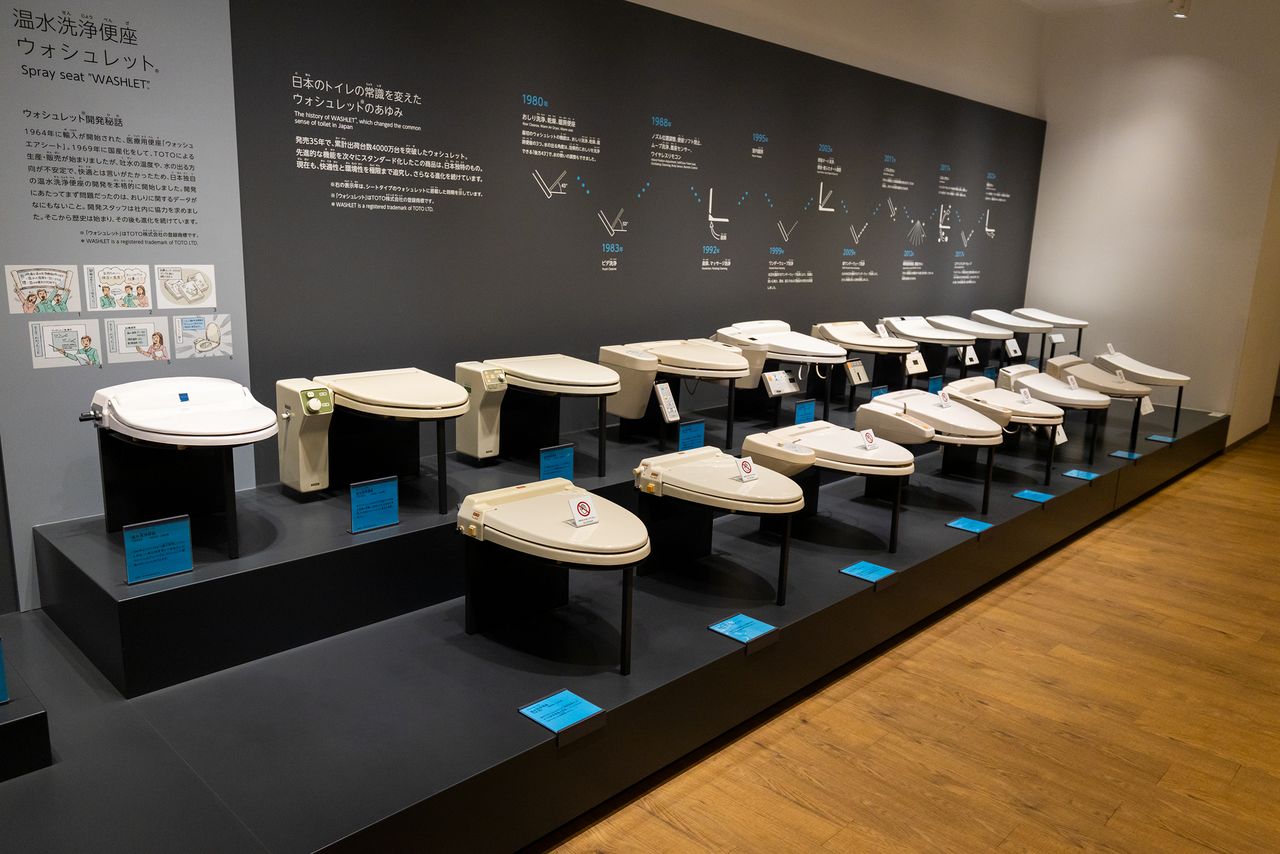
A display of Washlets, from the earliest models to the latest designs. (© Nippon.com)
The catch phrase that made the Washlet famous in its 1982 television commercial, aired during the dinner hour, was uttered by a popular celebrity: “Oshiri datte, aratte hoshii” (your bottom wants to be washed). The name Washlet, by the way, comes from a reversal of the English phrase “Let’s wash,” meaning something to do with your backside. The unusual idea of speaking from the perspective of the backside itself proved to be a winner, and consumers across Japan began to move from “wiping” to “washing.”
Over the years, evolution has continued with nozzle position adjustments, self-cleaning functions, and ozone deodorization, and these “backside washers” have become nearly universal.
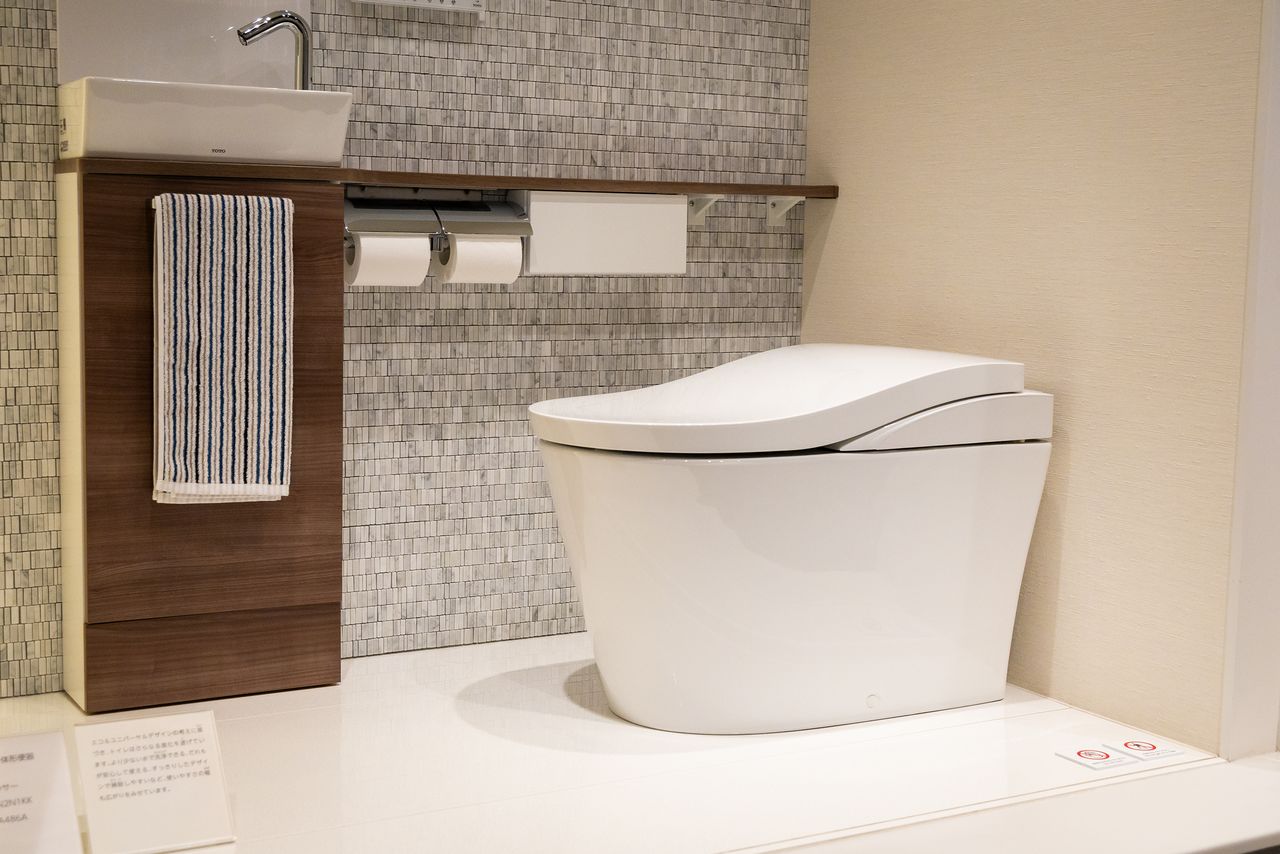
One of Toto’s latest products. According to the Japan Sanitary Equipment Industry Association, the total number of warm-water bidet toilet seats sold in Japan surpassed 100 million in June 2022. In August of that same year, Toto reached a total of 60 million Washlets sold (including overseas. (© Nippon.com)
Putting Growth Before Profit
The root of all this technical innovation is the dream passed down from founder Ōkura Kazuchika, who simply wanted people to have a “pleasant, sanitary lifestyle.” The best illustration of that is the company’s relationship with its rival manufacturer Inax, now known as Lixil.
The Ina family, who started out as potters in Tokoname, Aichi Prefecture, offered technical assistance during construction of the Imperial Hotel main building designed by Frank Lloyd Wright and then began producing porcelain for the construction business. Ōkura offered financial support for that shift, and the Ina Seitō company started out as a tile maker under the Morimura group in 1924. Ōkura Kazuchika, who supplied capital for the establishment, served as the first chairman of the board and occasionally supported even with his own funds to keep it in business.
During World War II, Ina Seitō began polishing its production techniques by making sanitary porcelain for the military. When the company consulted Ōkura about the possible conflict with fellow group company Tōyō Tōki, he approved of the company going independent, saying that a friendly rivalry would encourage growth in the field.
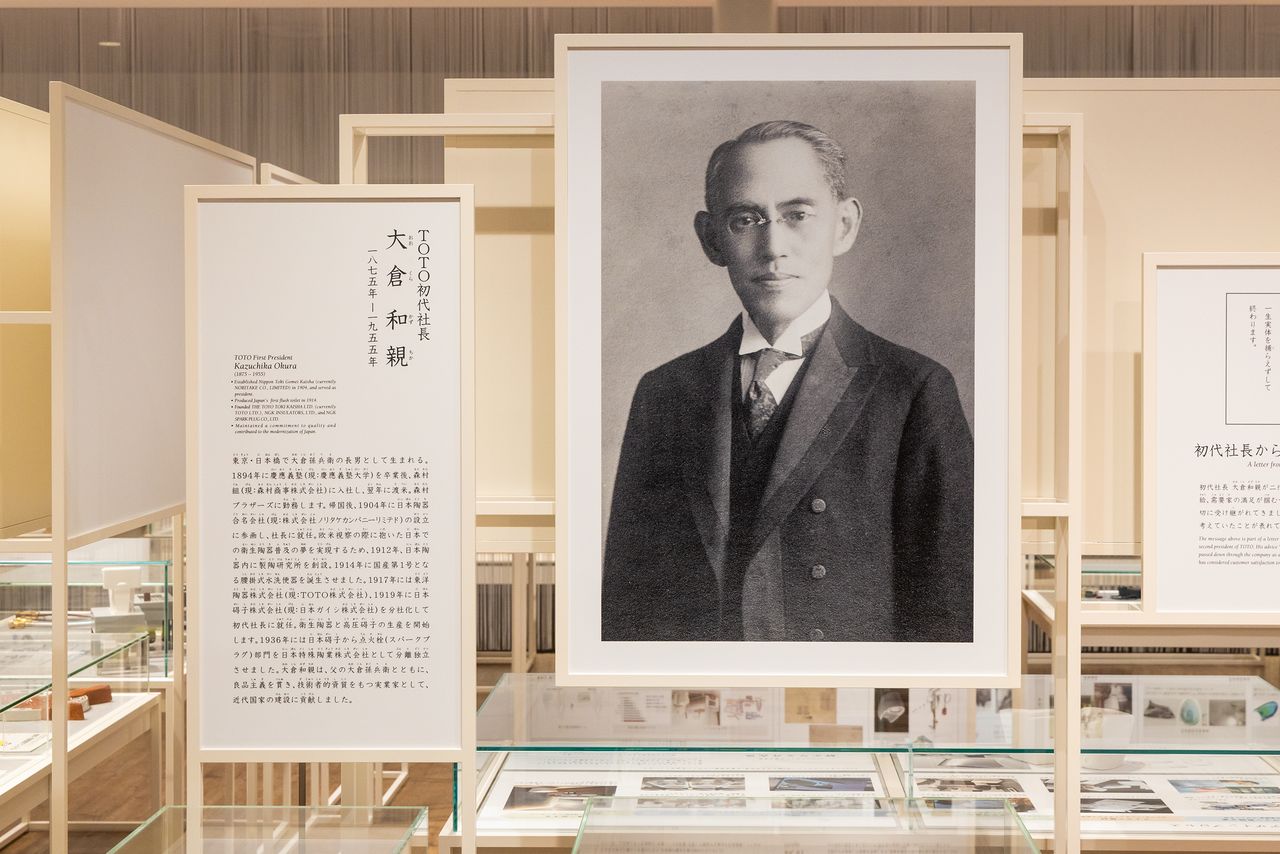
A portrait of Ōkura Kazuchika in Exhibition Room 2. (© Nippon.com)
The result is that Ina Seitō has grown into today’s Lixil (with its leading brand Inax), making for a good rival to Toto in technology and quality. These two major manufacturers have helped turn Japan into the world’s toilet leader.
Surely, this marks the culmination of Ōkura Kazuchika’s dream of a “pleasant, sanitary life.” The Toto Museum shows off how the tenacity and inexhaustible spirit of innovation of the employees who inherited that dream made it happen.
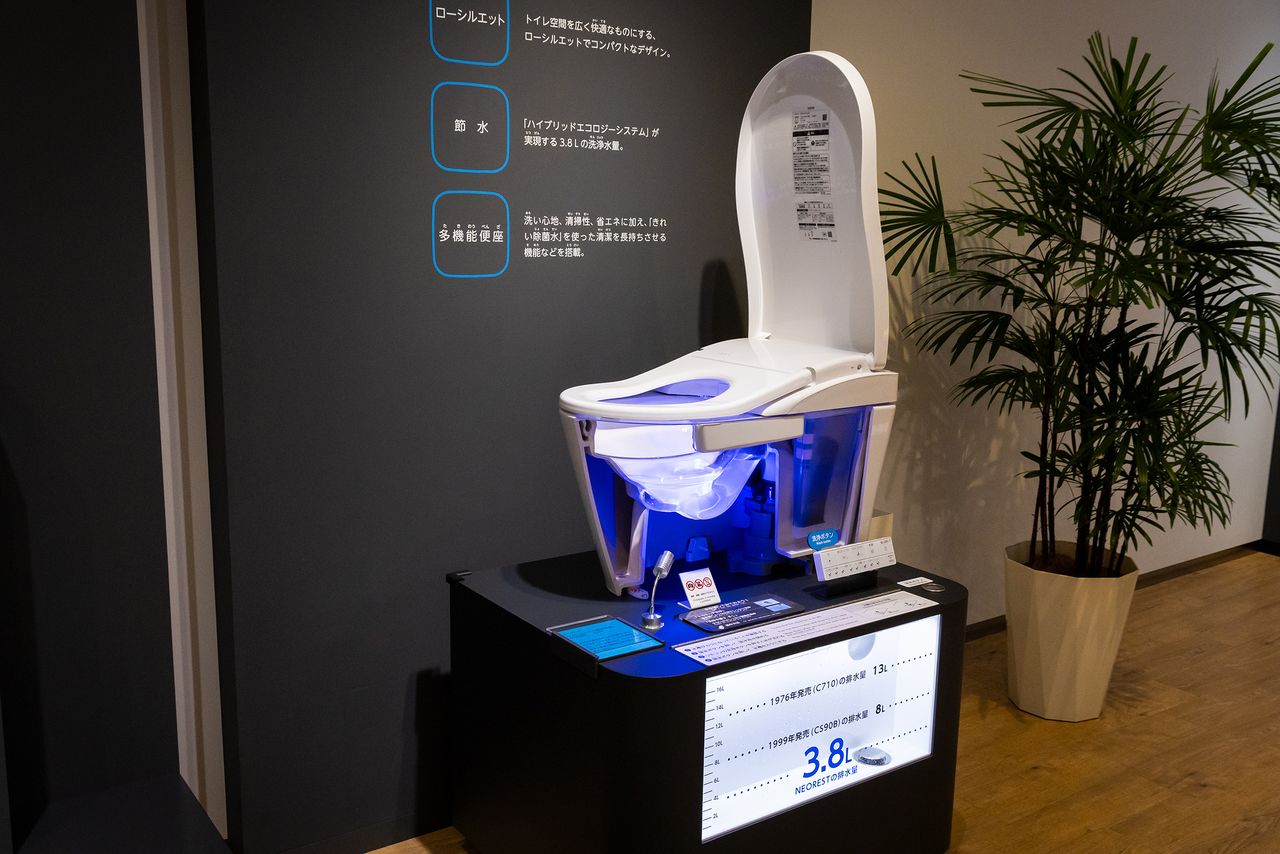
The latest Toto toilets have cut water use down to 3.8 liters per flush. (© Nippon.com)

There are also unique toilets on display, such as an extra-large unit made for sumo wrestlers at the Ryōgoku Kokugikan sumo hall. (© Nippon.com)

Exhibition Room 3 features Toto products developed around the world, such as the wall-mounted toilets popular in Europe. (© Nippon.com)
TOTO Museum
- Address: 1-1, Nakashima 2-chōme, Kokurakita-ku, Kitakyūshū, Fukuoka
- Closed: Mondays, summer holidays, year-end holidays
- Entry is free
- Website: https://www.toto.com/
(Originally published in Japanese on August 1, 2024. Banner photo: A Toto Museum display showcasing the changes in Western sit-down toilets. © Nippon.com.)
